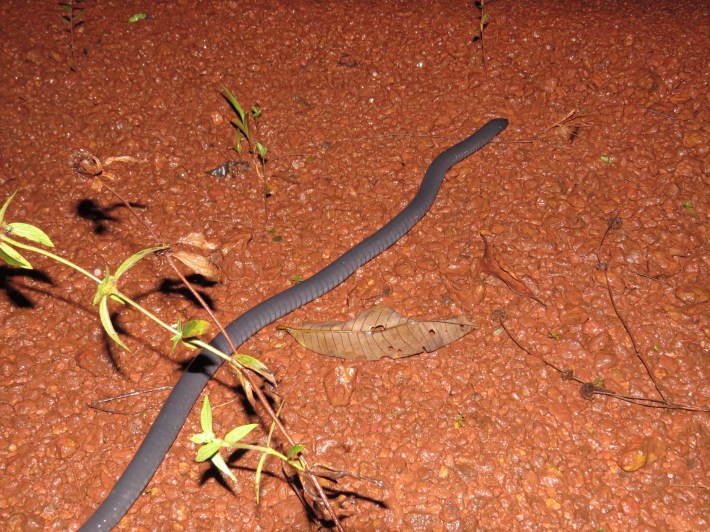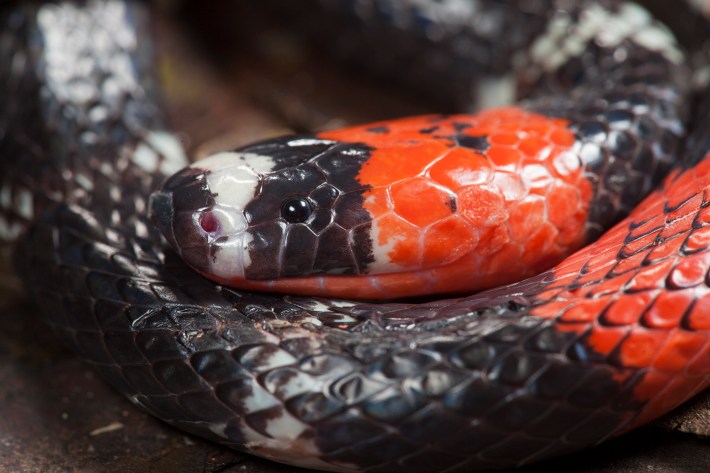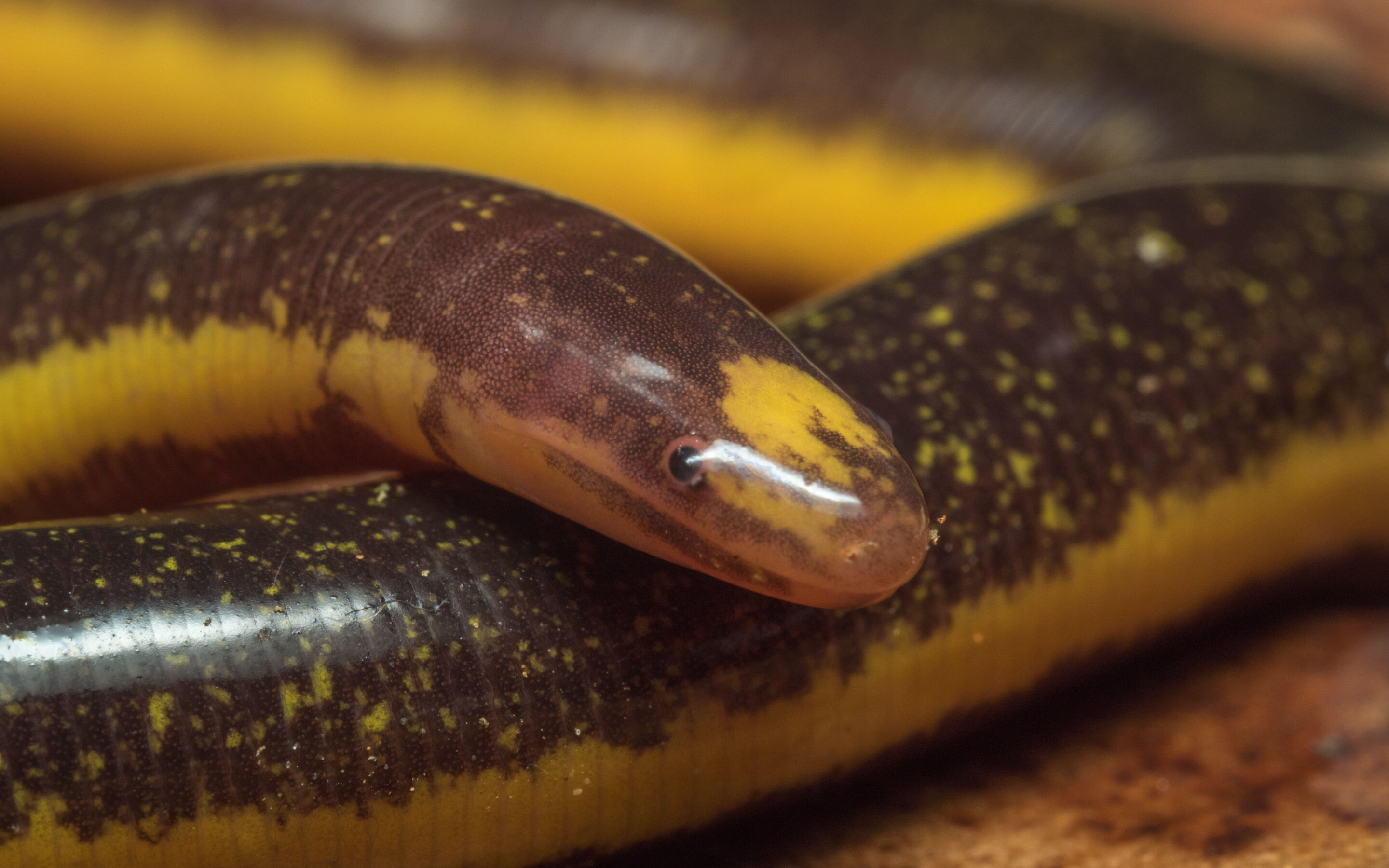To the touch, the legless amphibians known as caecilians feel like gummy worms emerging from a soap-slicked Slip 'N Slide. This is how Marco Mancuso, a former master's student at Vrije Universiteit Brussel, describes the wild caecilians he handled in French Guiana. "Very, very slippery," he said.
A caecilian's sliminess is also a defense mechanism, one that allows the mostly blind amphibians to slither away from the clumsy mouths of predators and grabby hands of scientists, escaping into their subterranean burrows. But even the slipperiest caecilian is no match for the hollow, syringe-like fangs of an elapid snake like a cobra. "If you're just jabbing in a needle, it doesn't matter how slippery they are," said Bryan Fry, a venom researcher at the University of Queensland in Australia. "You can eat them at your leisure after they die."
Caecilians were slipping and sliding in their own mucus long before of the rise of elapid snakes, which would have readily gobbled up the abundant amphibians. Yet caecilians around the world dodged extinction in part by evolving resistance to elapid snake venom at least 15 separate times, according to a new paper published by Mancuso, Fry, and colleagues in the International Journal of Molecular Sciences. "It's very directed evolution," said Marta Maria Antoniazzi, a researcher at the Butantan Institute in São Paulo, Brazil, who was not involved with the research. "Nature works like that," she added.
Despite their long evolutionary history, caecilians have remained somewhat of an underground amphibian, wriggling under the radar of the general public. "Ninety-eight percent of Italians don't know what a caecilian is," estimated Mancuso, who, it bears mentioning, is Sicilian. He originally wanted to study crocodiles and then snakes, but ended up studying under an amphibian expert. Mancuso, seeking a project, emailed some scientists he admired. Fry emailed back, asking if the student was interested in caecilians. (When I mentioned to Mancuso that the snake-like body of caecilians made them a great amphibian for a snake-lover, he laughed before reminding me that caecilians evolved long before snakes. "It's actually a snake that has a caecilian-like body plan.")

Fry, a venom researcher who became allergic to snake venom, has studied the evolution of venom resistance in many animals, such as honey badgers, which can survive cobra bites. He noticed prey animals that do develop resistance to venom tend to be slow moving and vulnerable. Blind, limbless caecilians fit the bill. "It seemed a natural case for them, at least some of them, to be resistant," Fry said.
The researchers collected tissue samples from 40 caecilian species in all 10 known families, sourced from specimens in museum collections. The venom of elapid snakes is neurotoxic, which, by binding to receptors, blocks the transmission of nerve impulses that allow the body to function normally. Blocking these messages can lead to muscle paralysis and death by respiratory failure. So the researchers sequenced a gene fragment containing a receptor protein bound by snake venom and analyzed the sequence for signs of venom resistance.
The researchers found that caecilians independently evolved resistance to elapid snake venom at least 15 separate times in their evolutionary history, which they say is a sign of how vulnerable the amphibians were to the scourge of snakes. Caecilians are not the only creatures that have evolved resistance to snake venom; mongooses and meerkats are resistant to cobra venom. But the mammals' resistance evolved in a common ancestor, whereas caecilians across the world clearly scrambled to adapt as snakes came on the scene. "Seeing evolution happening was really something amazing," Mancuso said.
The caecilians developed this resistance by three methods. The first method places an obstacle that prevents the toxin from binding to the pocket-shaped receptor. "Imagine you're putting a piece of shrubbery in the middle of that pocket," Fry said. The second method changes the shape of the receptor so the toxin no longer fits, akin to changing the locks so a key no longer works. The third method, also deployed by the honey badger, reverses the charge of the receptor, which is normally negative, to positive. This repels the positively-charged snake toxins. Finding all three of these mechanisms in caecilians reinforces the pressure they were under, Fry said.

Analyzing three species of caecilians found in the Seychelles, an archipelago absent any elapid snakes, the researchers found absolutely no resistance to snake venom. "If they showed any signatures of resistance, it would have meant there was a problem with our theory," Fry said. The Seychelles caecilians' lack of defenses suggested these species never needed to evolve resistance.
Unfortunately for many caecilians, this resistance is sometimes futile. Antoniazzi and Carlos Jared, also at the Butantan Institute, have spent hundreds of hours searching for caecilians in the wild, and encountered many dead caecilians in the stomachs of coral snakes. As such, they said they would like to see the researchers test living caecilians' resistance to these snakes. "We ask ourselves, does resistance really serve to protect the caecilians from the elapids?" Antoniazzi said. "Maybe a percentage of the caecilians are not eaten by the elapids because of the resistance, but the fact is that they are eaten."
Caecilians are so elusive that they are one of the most poorly known vertebrates, with many aspects of their physiology and behavior still mysterious. And what scientists do know is exceedingly strange. "The skin of a caecilian is full of poison glands," Jared said. "If you stay with a caecilian for some time, you need to sneeze." In a very unique form of parental care, baby caecilians tear off and eat their mother's outermost layer of skin. Mancuso's favorite caecilian trait are their tiny tentacles, which poke out of their face and are derived from the tear duct. "You don't know how many times I get the thing, 'Oh you study snakes, how disgusting,'" Mancuso said. "I say, you should see a caecilian."






